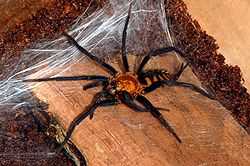Dipluridae
| Funnel-web tarantulas Temporal range: Early Cretaceous-Recent | |
|---|---|
 | |
| Linothele fallax | |
| Scientific classification | |
| Kingdom: | Animalia |
| Phylum: | Arthropoda |
| Class: | Arachnida |
| Order: | Araneae |
| Suborder: | Mygalomorphae |
| Infraorder: | Tuberculotae |
| Superfamily: | Dipluroidea |
| Family: | Dipluridae Simon, 1889 |
| Genera | |
|
Diplura | |
| Diversity | |
| 24 genera, 174 species | |
 | |

Funnel-web tarantulas (superfamily Dipluroidea,[1] family Dipluridae), are a group of spiders in the infraorder Mygalomorphae, that have two pairs of booklungs, and chelicerae (fangs) that move up and down in a stabbing motion. A number of genera, including that of the Sydney funnel-web spider (Atrax), used to be classified in this family but have now been moved to Hexathelidae.
Description
Dipluridae lack a rastellum (stout conical spines) on their chelicerae. Their carapace is characterized by the head region not being higher than the thoracic region. Their posterior median spinnerets (silk-extruding organs) are much shorter than their posterior lateral spinnerets, which have three segments, and are elongated (almost as long as their opisthosoma). Most of the species are medium to small-sized spiders, with some, such as the endangered Microhexura montivaga, as small as 3 mm, while others may measure about 15 mm.[2] The cave species Masteria caeca is eyeless.
Biology
Members of this family often build rather messy funnel-webs. Some build silk-lined burrows instead of webs (Diplura, Trechona, some Linothele sp.). They generally build their retreats in crevices in earthen banks, the bark of trees, under logs or in leaf litter.[2]
Distribution
Dipluridae occur almost worldwide in the tropics. Most are found in Central and South America, and many occur in the Australian region. Indothele is found in India and Sri Lanka. Ischnothele is a neotropical genus, but one species occurs only in India. Several genera are found in Africa, with Thelechoris also occurring in Madagascar. Leptothele and Phyxioschema suthepium are endemic to Thailand, with the other Phyxioschema species found in Central Asia. Masteria is widely distributed, with species found in places such as Central America, Fiji, the Philippines, Queensland and New Guinea.[3]
The common genus in the United States is Euagrus, which builds its webs under stones in wet canyons. It is abundant in such areas as the Chiricahua Mountains of Arizona.
Diplurids can be very common in banks and road cuts, such as in Trinidad.
Human interaction
There is no proper proof on the toxicity of their venom, but it is probably wise to avoid direct contact with the larger members (Diplura sp., Harmonicon sp., Linothele sp., and Trechona sp.).[citation needed]
The highly venomous genus Atrax used to be placed in this family, but is now in the Hexathelidae.
Genera
The grouping into subfamilies follows Raven, R. J. (1985a), and Coyle, F. A. (1984, 1986, 1988, 1995):
- Diplurinae Simon, 1889
- † Clostes Menge, 1869 — fossil, Eocene Baltic amber
- † Clostes priscus (Menge, 1869)
- † Cretadiplura Selden, 2005 — fossil, Early Cretaceous
- † Cretadiplura ceara Selden, 2005
- † Dinodiplura Selden, 2005 — fossil, Lower Cretaceous
- † Dinodiplura ambulacra Selden, 2005
- Diplura C. L. Koch, 1850 — South America, Cuba
- Harmonicon F. O. P-Cambridge, 1896 — French Guiana, Brazil
- Linothele Karsch, 1879 — South America
- Trechona C. L. Koch, 1850 — South America
- Euagrinae Raven, 1979
- Allothele Tucker, 1920 — Africa
- Australothele Raven, 1984 — Australia
- Caledothele Raven, 1991 — Australia
- Carrai Raven, 1984 — New South Wales
- Cethegus Thorell, 1881 — Australia
- Euagrus Ausserer, 1875 — Southern USA to Costa Rica, South Africa, Taiwan
- Microhexura Crosby & Bishop, 1925 — USA
- Namirea Raven, 1984 — Australia
- Phyxioschema Simon, 1889 — Central Asia
- Stenygrocercus Simon, 1892 — New Caledonia
- Ischnothelinae F. O. Pickard-Cambridge, 1897
- Andethele Coyle, 1995 — Peru
- Indothele Coyle, 1995 — India
- Ischnothele Ausserer, 1875 — Mexico to Argentina, Caribbean, India
- Lathrothele Benoit, 1965 — Africa
- Thelechoris Karsch, 1881 — Africa, Madagascar
- Masteriinae Simon, 1889
- Chilehexops Coyle, 1986 — Chile, Argentina
- Masteria L. Koch, 1873 — Caribbean, Central and South America, Oceania, Australia
- Striamea Raven, 1981 — Colombia
- incertae sedis
- Leptothele Raven & Schwendinger, 1995 — Thailand
- Troglodiplura Main, 1969 — Australia
See also
- Spider families
Footnotes
References
- Murphy, Frances & Murphy, John (2000): An Introduction to the Spiders of South East Asia. Malaysian Nature Society, Kuala Lumpur.
- Platnick, Norman I. (2008): The world spider catalog, version 8.5. American Museum of Natural History.
Further reading
- Chickering, A. M. (1964): Two new species of the genus Accola (Araneae, Dipluridae). Psyche 71: 174-180. PDF
- Coyle, F. A. (1986): Chilehexops, a new funnelweb mygalomorph spider genus from Chile (Araneae, Dipluridae). Am. Mus. Novit. 2860: 1-10. PDF
- Goloboff, Pablo A. (1994): Linothele cavicola, a new Diplurinae spider (Araneae, Dipluridae) from the caves in Ecuador. J. Arachnol. 22: 70-72. PDF
- Selden, P.A., da Costa Casado, F. & Vianna Mesquita, M. (2005): Mygalomorph spiders (Araneae: Dipluridae) from the Lower Cretaceous Crato Lagerstätte, Araripe Basin, North-east Brazil. Palaeontology 49(4): 817-826. doi:10.1111/j.1475-4983.2006.00561.x
External links
| Wikispecies has information related to: Dipluridae |
| Wikimedia Commons has media related to Dipluridae. |
- Platnick, Norman I. (2008): The world spider catalog, version 8.5. American Museum of Natural History.
- Taxonomy, housing and captive breeding of Dipluridae sp. including key to all genera
| |||||||||||||||||||